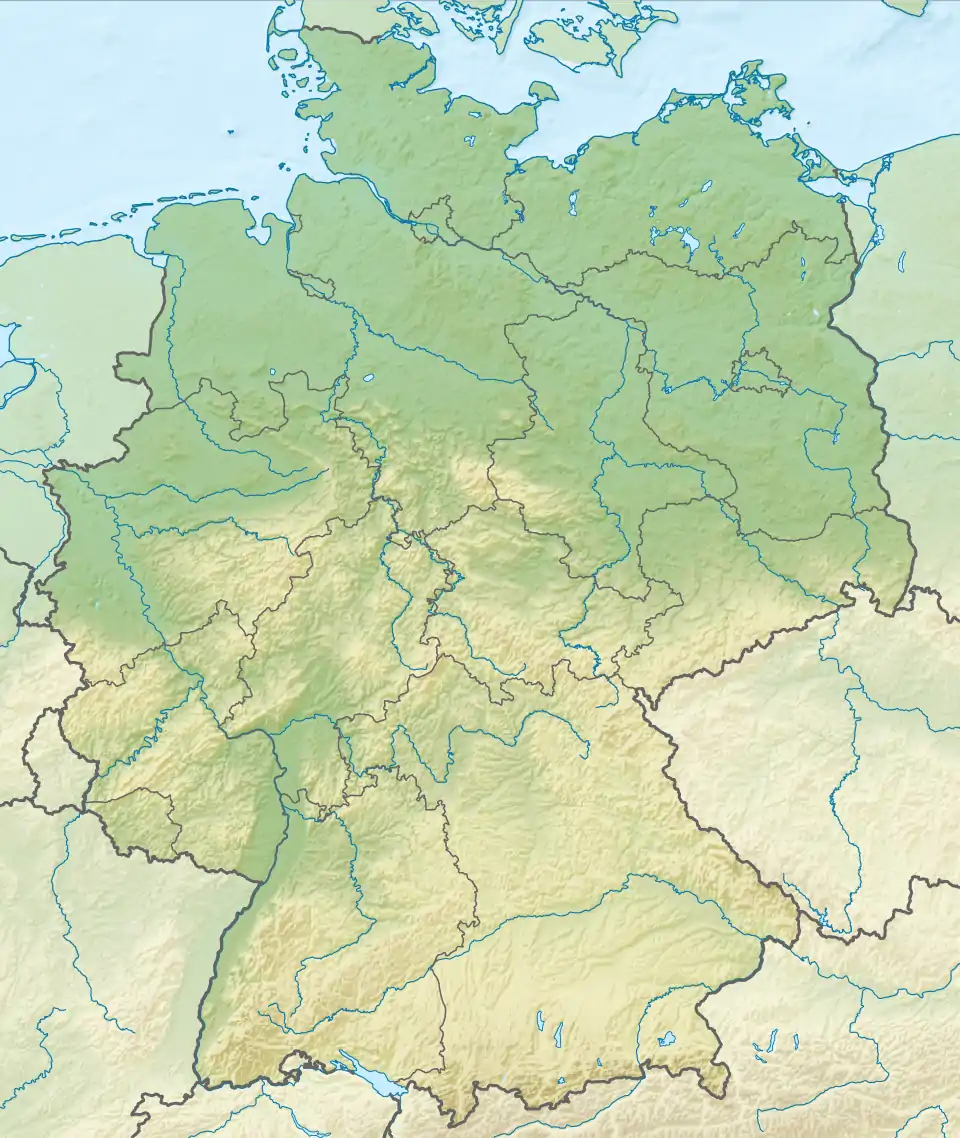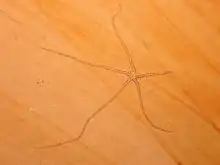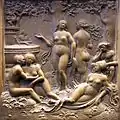Solnhofen Limestone
The Solnhofen Plattenkalk, or Solnhofen Limestone, geologically known as the Altmühltal Formation, is a Jurassic Konservat-Lagerstätte that preserves a rare assemblage of fossilized organisms, including highly detailed imprints of soft bodied organisms such as sea jellies. The most familiar fossils of the Solnhofen Plattenkalk include the early feathered theropod dinosaur Archaeopteryx preserved in such detail that they are among the most famous and most beautiful fossils in the world. The Solnhofen beds lie in the German state of Bavaria (Bayern), halfway between Nuremberg (Nürnberg) and Munich (München) and were originally quarried as a source of lithographic limestone. The Jura Museum situated in Eichstätt, Germany has an extensive exhibit of Jurassic fossils from the quarries of Solnhofen and surroundings, including marine reptiles, pterosaurs, and one specimen of the early bird Archaeopteryx.[3]
| Altmühltal Formation Stratigraphic range: Tithonian [1][2] | |
|---|---|
 Outcrop of the Solnhofen Limestone | |
| Type | Geological formation |
| Underlies | Mornsheim Formation[1] |
| Overlies | Rögling Formation[1] |
| Lithology | |
| Primary | Lithographic limestone[1] |
| Location | |
| Coordinates | 48.9000°N 11.0000°E |
| Approximate paleocoordinates | 40.1°N 19.2°E |
| Region | |
| Country | |
| Type section | |
| Named for | Solnhofen |
 Solnhofen Limestone (Germany)  Solnhofen Limestone (Bavaria) | |
Paleoenvironment and preservation

During the Late Jurassic, this area was an archipelago at the edge of the Tethys Sea. This included placid lagoons that had limited access to the open sea and where salinity rose high enough that the resulting brine could not support life. Since the lowest water was devoid of oxygen, many ordinary scavengers were absent. Any organism that fell, drifted, or was washed into the lagoons from the ocean or the land became buried in soft carbonate mud. Thus, many delicate creatures avoided consumption by scavengers or being torn apart by currents. The wings of dragonflies, the imprints of stray feathers, and terrestrial plants that washed into the lagoons were all preserved. The fossils are not numerous, but some of them are spectacular, and their range gives a comprehensive picture of a local Jurassic ecosystem.
At times, the lagoons almost dried out, exposing sticky carbonate muds that trapped insects and a few small dinosaurs. Over 600 species have been identified, including twenty-nine kinds of pterosaur ranging from the size of a sparrow to 1.2 m (4 ft) in length.
The fine-grained texture of the mud silt forming the limestone from the Solnhofen area (which is composed mainly of the towns of Solnhofen and Eichstätt) is ideal for making lithographic plates, and extensive quarrying in the 19th century revealed many fossil finds, as commemorated in the name Archaeopteryx lithographica, all the specimens of which come from these deposits. The closest modern analogue to the Solnhofen conditions is said to be Orca Basin in the northern Gulf of Mexico, though that area is much deeper than the Solnhofen lagoons.[4]
Paleobiota
Significant members of the Solnhofen paleofauna include Archaeopteryx, pterosaurs, and marine invertebrates.
Cultural goods made from Solnhofen Plattenkalk

 Garden of Love/Fountain of Youth, 1525 by Loy Hering (Bode-Museum Berlin)
Garden of Love/Fountain of Youth, 1525 by Loy Hering (Bode-Museum Berlin) Susannah and the Elders, 1530 by Victor Kayser (Bode-Museum Berlin)
Susannah and the Elders, 1530 by Victor Kayser (Bode-Museum Berlin) Salome Receives the Head of St. John the Baptist in the Dungeon, 1648 by Georg Schweigger
Salome Receives the Head of St. John the Baptist in the Dungeon, 1648 by Georg Schweigger
See also
- Jura Museum
- List of fossil sites (with link directory)
- List of types of limestone
- List of dinosaur-bearing rock formations
- South German Jurassic
References
- Rauhut, O. W., Heyng, A. M., López-Arbarello, A., & Hecker, A. (2012). A new rhynchocephalian from the Late Jurassic of Germany with a dentition that is unique amongst tetrapods. PLoS ONE, 7(10): e46839.
- Schweigert, G. 2007. Ammonite biostratigraphy as a tool for dating Upper Jurassic lithographic limestones from South Germany – first results and open questions." Neues Jahrbuch für Geologie und Paläontologie - Abhandlungen, 245(1): 117-125. doi:10.1127/0077-7749/2007/0245-0117
- "Jura-Museum Eichstätt".
- Bartell K.W., Swinburne N.H.M. and Conway-Morris S. 1990. Solnhofen: a study in Mesozoic palaeontology. Cambridge (transl. and revised from Bartel K.W. 1978. Ein Blick in die Erdgeschichte. Ott.
External links
| Wikimedia Commons has media related to Solnhofen limestone. |